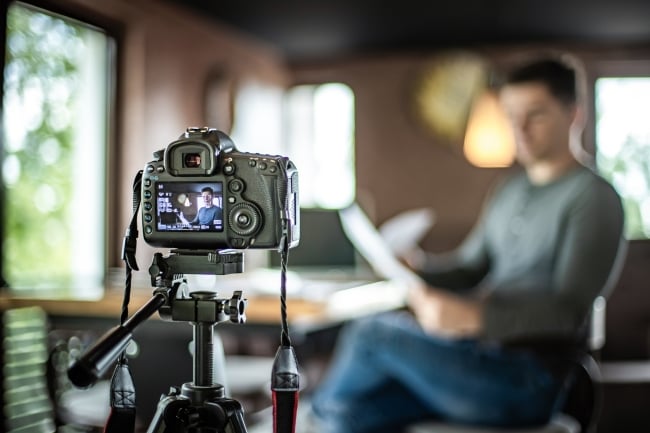You have /5 articles left.
Sign up for a free account or log in.

A Villanova professor allows students to prerecord their final presentations to alleviate stress and improve outcomes.
Milan Markovic/E+/Getty Images
Public speaking can be a frightening experience for many students and, for classes where that isn’t the focus, create undue pressure to perform.
In teaching graduate courses, Seth Fishman, associate teaching professor of education and counseling at Villanova University, assigned students to create and deliver live presentations to their peers about their final projects and research papers.
During the pandemic, Fishman altered the format to allow students to share recorded presentations and found the modality resulted in better presentations, more innovation and less anxiety and trepidation.
How it works: Fishman taught History of U.S. Higher Education online during the fall 2020 term due to the COVID-19 pandemic.
He gave the students two options: present live on Zoom or record a 10-minute presentation, which the class would watch during the Zoom meeting. Both live and recorded presenters completed a few minutes of Q&A from Fishman and their peers afterward.
Fishman does not put limits on how presentations should be delivered, but many students opt to create a PowerPoint, Prezzy or Canva presentation. Around 80 percent of students wind up recording their presentations, but some still deliver them live.
The impact: Recording presentations, in addition to giving students the ability to modify and improve their presentations, has resulted in overall better presentations for the class and Fishman.
Typical challenges like students talking too fast, speaking at various volumes or stumbling over a word are often replaced with creativity and innovation.
“A student created a film noir detective-theme video, complete with faux Bogart voiceovers and a special appearance from his daughter,” Fishman wrote in a journal article. “This was the first video he ever made and had his fellow co-workers watch it in an advance screening. Another video was a voiceover worthy of Ken Burns admiration comparing the higher education response to the 1918 influenza pandemic to COVID.”
Students are more confident and competent in their delivery with recorded lectures, and their grades have reflected this, Fishman says. Fishman uses the same rubric to grade live and recorded presentations but places the most weight on the live question-and-answer segment because that’s where Fishman sees their skills needed the most in responding to unexpected questions.
Improved Tech Timing
Tech challenges were one motivator for prerecorded lectures, shares Villanova professor Seth Fishman. The university requires students to provide their own computer, and the classroom space Fishman has used required learners to fumble with a faculty podium switchboard with six various plug-ins for different devices.
Fishman estimates each class period sacrificed at least 10 minutes to wrestling with the various cords, passing around a flash drive or emailing and downloading large files to present on Fishman’s computer.
Since allowing for prerecorded lessons, students now email Fishman a web link, which has saved class time and gives him a record of delivery and future example for the next group of students.
Some students are still underprepared in recorded versions, clearly reading off their notes or relying on too many visual effects, but over all Fishman has seen more engaging and creative presentations from the recorded versions.
In course evaluations, students have also mentioned their preference for the recorded option so they could make mistakes and self-evaluate prior to submission.
The case for empathy: Public speaking is a people skill that remains important in workforce preparedness. While there are some situations in which students may be required to present in a live setting, Fishman does not expect his students to be experts at public speaking.
“I’m teaching higher education leadership students, mostly entering entry- to midlevel career roles,” Fishman says. “They don’t need to give 20-minute presentations or write 40-page papers.”
Instead, he sees the tech skill development required to create and record a digital presentation as just as important, and the assignment empowers graduate students to try something new and focus on good design elements.
Universal design for learning also encourages faculty members to consider multiple options to demonstrate learning. “It evens the playing field for those who may have anxiety, stress or do not like to be the center of attention, while allowing for more creativity,” Fishman says.
Though he no longer teaches online classes, “I’ll never go back to requiring them to go live, unless I have to,” Fishman says.
Do you have an academic success tip that might help others encourage student success? Tell us about it.




